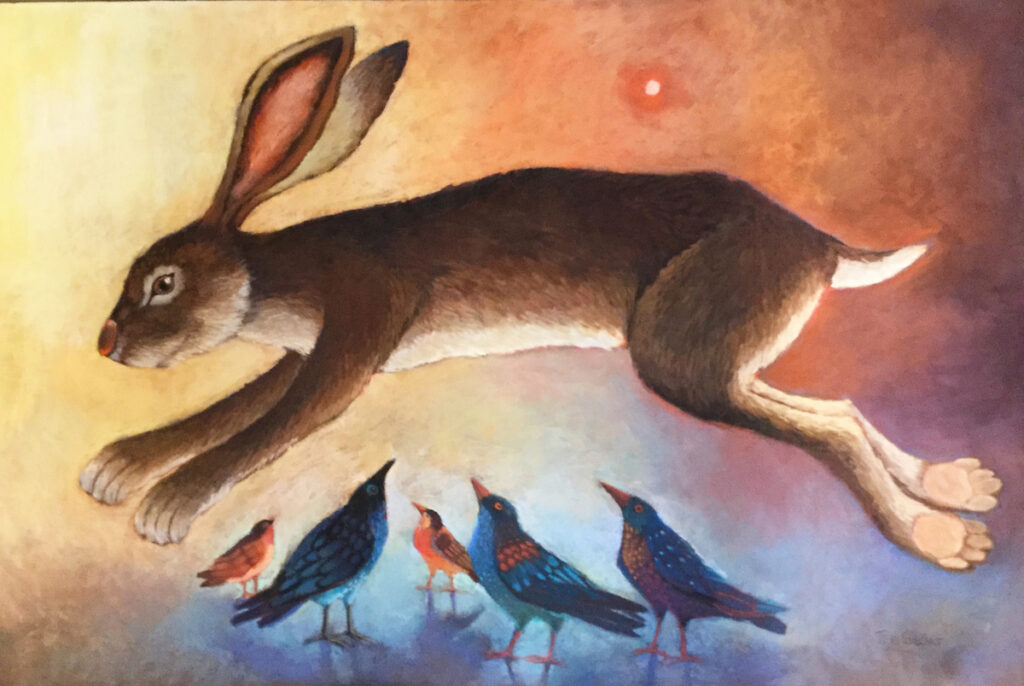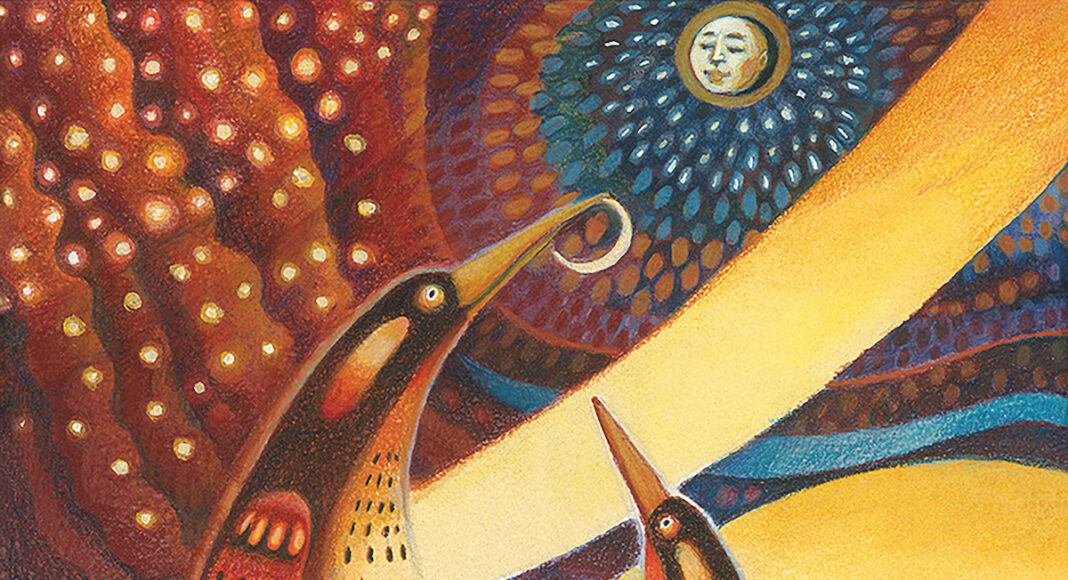A familiar face amongst the West County art scene, artist Teri Sloat’s work is included in this year’s Sonoma County Art Trails.
Community members can see Art Trails Oct. 1 and 2 at the Sebastopol Center for the Arts. Sloat’s work covers a range of subject matter; she’s a talented landscape painter who masterfully renders color and light in pastel, and she also paints a great deal of folk art.
Though traditional in style, the stories of Sloat’s folk art are her own.
Sloat paints her own mythos, adding it to the annals of folklore and inviting viewers of her work to translate what they see for themselves—to mine meaning the way one would from an Aesop fable.
Sloat didn’t go to art school and was never classically trained. Her career as an artist came as the result of her passion, gumption and willingness to take the opportunities life presented her, even if she didn’t feel ready for them.
Her creativity iterated in early childhood, where she found an outlet for her creative impulses in drawing greeting cards for her family and friends, as early as when she was four years old.
“For some reason, my mother, though we had absolutely no supplemental money, bought me a year of art lessons with a painter. I became totally addicted to the smell of paint, the color, the work hanging up on the walls; it gave me a real boost,” Sloat recalled.
She began to notice too, the intricate backdrops of Walt Disney animated movies; the moody backgrounds evoked a sense of marvel at the power and mood-bringing capacity of color. She continued drawing and illustrating, on her own time.
In the 1960s, Sloat met and married her husband, and together they moved to Alaska, to teach in Yup’ik villages at the mouth of the Yukon River. Sloat became fascinated with picture book illustrations, and which images her primarily Yupik-speaking students would respond to, while still learning English. Then, opportunity struck.
“After five years of teaching, I was considering making my own book, with my illustration. Then in 1976, a bilingual center was opened in Bethel, and a job opened up to create books and reading materials and posters for the classrooms of Yu’pik schools all along the Yukon Delta. I turned in all the greeting cards I’d been making, and my idea for a book, and there wasn’t another person for 400 miles around who could do the job. So I got it.”
This stroke of opportunity catapulted Sloat’s career. Though she felt her work atrocious at the time, she was utterly content with her new role. She created readers, picture books and posters, all based around the Yu’pik culture’s folklore. This exposure to intimate cultural story served to awaken Sloat’s imagination and inform her own folkloric paintings.
After seven years in the job, she had illustrated 250 books, alphabets and readers, and felt ready to pursue her artistic goals. Sloat’s first illustrated book, an alphabet book titled Letter to Letter, came out in 1989. She now has 22 illustrated children’s books under her belt.
Along with her impressive career as a children’s book author and illustrator, Sloat’s love of the natural world, deeply enhanced by her time living in the awe-inducing magnitude of the Alaskan tundra—she and her family traveled by sea plane and sled, and listened to local stories on long nights—and her ongoing exposure to Yu’pik folklore, shaped her visual work into the two-sided body of paintings it is today. Both in her landscapes and her folkloric work, she seeks to convey the interconnectedness between humans and the natural world—finding in the process of painting a sense of connectedness herself.
“I’ve had to learn to pay attention to where my imagination is going, and honor those stories. More and more, I realize that we all have thoughts, stories, about how connected we are. Catching those stories and putting them down visually can connect to another person. It can inspire their own stories.”
Though she is always careful to attribute her inspirations to their original sources and otherwise avoid appropriation—Sloat feels anyone can craft and create folklore. And she feels that her paintings offer an invitation to create our own stories, our own folklore. Often a speaker in schools, at conferences and in various art programs, Sloat teaches that all folklore starts somewhere, and there’s no reason that it can’t start with us.
“I have pieces with imagery—one example is a piece called The Last Sliver of the Moon, and one of the birds has the last sliver in its beak. And it’s up to you to create the rest of the story! It’s not a folktale in a standard sense; it’s just mine. And the picture is a thought that produces a story in someone else. I so enjoy that. Unless someone asks me, I don’t tell them the whole story, because I want to know what they’re thinking.”
One such inspirational image is Sloat’s painting, Who Needs Wings, which depicts a jackrabbit leaping over birds. For Sloat, the image was born from her processing of accepting her validity as an artist without ever having been classically trained.
Astounding though it may seem while reading about her long and successful career, Sloat experienced something that can be common among “outside artists”—artists not classically trained—and artists in general: a sense of guilt, or apology for making her work, a general imposter syndrome, and a need to justify and improve, constantly.
Now in the later years of her life as an artist, Sloat has found her way through and out of that feeling of guilt, and into a sense of certainty about her work, and herself as an artist. Creating, in Who Needs Wings a story, a piece of folklore, helped her to find closure with the process, and also a way to represent it to others perhaps experiencing the same thing.

“Who Needs Wings for me was a last remark to the part of myself that didn’t feel good enough. I think for a long time it was a struggle. Even quitting teaching—I felt such tremendous pressure to prove that had been a good decision. I think I’ve always been an apologetic artist, until lately. For the first time, in the last two or three years, after all this time, I’ve found my own message. I am able to create my own folklore, my own narrative, and that’s all I have to do.”
Now, in an unbarred way, Sloat protects and cultivates her craft, knowing that the side-eye modern culture might give those choosing their own path is one that can be met with a full, confident gaze.
“It’s very important, in those moments when someone looks at you with doubt, to look straight back at them and say this is my job.”
Even, and especially when that person is the one looking back at us in the mirror.
Sloat’s work, and Sloat herself, can be found Oct. 1 and 2 at the Sebastopol Center for the Arts, 282 S High St., Sebastopol. www.sonomacountyarttrails.org. For more of her work, visit www.terisloatfineart.com.











